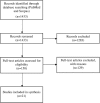Managing alarm systems for quality and safety in the hospital setting
- PMID: 30094341
- PMCID: PMC6069923
- DOI: 10.1136/bmjoq-2017-000202
Managing alarm systems for quality and safety in the hospital setting
Abstract
Objective: To provide an overview of documented studies and initiatives that demonstrate efforts to manage and improve alarm systems for quality in healthcare by human, organisational and technical factors.
Methods: A literature review, a grey literature review, interviews and a review of alarm-related standards (IEC 60601-1-8, IEC 62366-1:2015 and ANSI/Advancement of Medical Instrumentation HE 75:2009/2013) were conducted. Qualitative analysis was conducted to identify common themes of improvement elements in the literature and grey literature reviews, interviews and the review of alarm-related standards.
Results: 21 articles and 7 publications on alarm quality improvement work were included in the literature and grey literature reviews, in which 10 themes of improvement elements were identified. The 10 themes were categorised into human factors (alarm training and education, multidisciplinary teamwork, alarm safety culture), organisational factors (alarm protocols and standard procedures, alarm assessment and evaluation, alarm inventory and prioritisation, and sharing and learning) and technical factors (machine learning, alarm configuration and alarm design). 26 clinicians were interviewed. 9 of the 10 themes were identified from the interview responses. The review of the standards identified 3 of the 10 themes. The study findings are also presented in a step-by-step guide to optimise implementation of the improvement elements for healthcare organisations.
Conclusions: Improving alarm safety can be achieved by incorporating human, organisational and technical factors in an integrated approach. There is still a gap between alarm-related standards and how the standards are translated into practice, especially in a clinical environment that uses multiple alarming medical devices from different manufacturers. Standardisation across devices and manufacturers and the use of machine learning in improving alarm safety should be discussed in future collaboration between alarm manufacturers, end users and regulators.
Keywords: human factors; management; patient safety; quality improvement.
Conflict of interest statement
Competing interests: None declared.
Figures
References
-
- International Electrotechnical Commission. IEC 60601-1-8 Medical electrical equipment - Part 1-8: General requirements for basic safety and essential performance. Collateral Standard: General requirements, tests and guidance for alarm systems in medical electrical equipment and medical electrical systems. Geneva, Switzerland: International Electrotechnical Commission, 2012..
-
- AAMI Foundation. Clinical alarm: 2011 Summit convened by AAMI, FDA, TJA, ACCE and ECRI Institute. 2011. http://s3.amazonaws.com/rdcms-aami/files/production/public/FileDownloads....
-
- ECRI Institute. ECRI Institute Announces Top 10 Health Technology Hazards for 2015. https://www.ecri.org/press/Pages/ECRI-Institute-Announces-Top-10-Health-....
-
- Kowalczyk L. Suit over cardiac monitor settled - MGH patient died despite alarms. Boston Globe 2011.
LinkOut - more resources
Full Text Sources
Other Literature Sources
Miscellaneous


